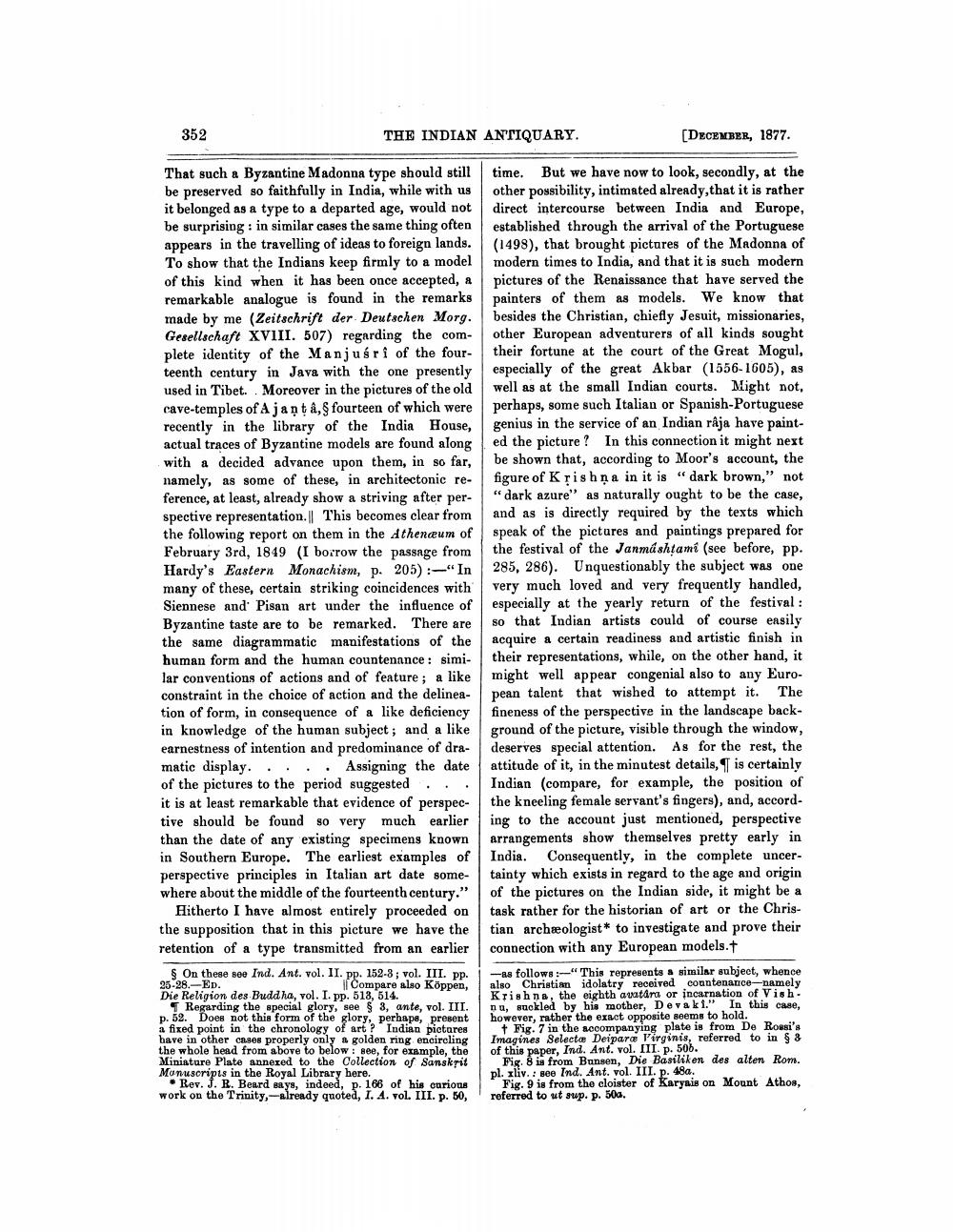________________
352
THE INDIAN ANTIQUARY.
[DECEMBER, 1877.
That such a Byzantine Madonna type should still time. But we have now to look, secondly, at the be preserved so faithfully in India, while with us other possibility, intimated already, that it is rather it belonged as a type to a departed age, would not direct intercourse between India and Europe, be surprising: in similar cases the same thing often established through the arrival of the Portuguese appears in the travelling of ideas to foreign lands. (1498), that brought pictures of the Madonna of To show that the Indians keep firmly to a model modern times to India, and that it is such modern of this kind when it has been once accepted, & pictures of the Renaissance that have served the remarkable analogue is found in the remarks painters of them as models. We know that made by me (Zeitschrift der Deutschen Morg. besides the Christian, chiefly Jesuit, missionaries, Gesellschaft XVIII. 507) regarding the com- other European adventurers of all kinds sought plete identity of the Manjusri of the four- their fortune at the court of the Great Mogul, teenth century in Java with the one presently especially of the great Akbar (1556-1605), as used in Tibet. . Moreover in the pictures of the old well as at the small Indian courts. Might not, cave-temples of Ajanta,fourteen of which were perhaps, some such Italian or Spanish-Portuguese recently in the library of the India House, genius in the service of an Indian râja have paintactual traces of Byzantine models are found alonged the picture? In this connection it might next with a decided advance upon them, in so far, be shown that, according to Moor's account, the namely, as some of these, in architectonic re- figure of Krishna in it is "dark brown," not ference, at least, already show a striving after per- "dark azure" as naturally ought to be the case, spective representation. This becomes clear from and as is directly required by the texts which the following report on them in the Atheneum of speak of the pictures and paintings prepared for February 3rd, 1849 (I borrow the passage from the festival of the Janmáshtami (see before, pp. Hardy's Eastern Monachism, p. 205) :-"In 285, 286). Unquestionably the subject was one many of these, certain striking coincidences with very much loved and very frequently handled, Siennese and Pisan art under the influence of especially at the yearly return of the festival : Byzantine taste are to be remarked. There are so that Indian artists could of course ensily he same diagrammatic manifestations of the acquire a certain readiness and artistic finish in human form and the human countenance : simi- their representations, while, on the other hand, it lar conventions of actions and of feature; a like might well appear congenial also to any Euroconstraint in the choice of action and the delinea- pean talent that wished to attempt it. The tion of form, in consequence of a like deficiency fineness of the perspective in the landscape backin knowledge of the human subject; and a like ground of the picture, visible through the window, earnestness of intention and predominance of dra- deserves special attention. As for the rest, the matic display. .... Assigning the date attitude of it, in the minutest details, is certainly of the pictures to the period suggested .. . Indian (compare, for example, the position of it is at least remarkable that evidence of perspec- the kneeling female servant's fingers), and, accordtive should be found so very much earlier ing to the account just mentioned, perspective than the date of any existing specimens known arrangements show themselves pretty early in in Southern Europe. The earliest examples of India. Consequently, in the complete uncerperspective principles in Italian art date some- tainty which exists in regard to the age and origin where about the middle of the fourteenth century." of the pictures on the Indian side, it might be a
Hitherto I have almost entirely proceeded on task rather for the historian of art or the Christhe supposition that in this picture we have the tian archæologist* to investigate and prove their retention of a type transmitted from an earlier connection with any European models.
On these see Ind. Ant. vol. II. pp. 152-3; vol. III. pp. 1 -as follows:"This represents similar subject, whence 25-28.-E .
Compare also Köppen, also Christian idolatry received countenancehamely Die Religion des Buddha, vol. I. pp. 513, 514.
Krishna, the eighth avatars or incarnation of VishRegarding the special glory, see $ 3, ante, vol. III. na, suckled by his mother, Deva k 1." In this case, p. 52. Does not this form of the glory, perhape, present however, rather the exact opposite seems to hold a fixed point in the chronology of art ? Indian pictures + Fig. 7 in the accompanying plate is from De Rossi's have in other cases properly only a golden ring encircling Imagines Selectae Deiparæ Virginis, referred to in 3 the whole head from above to below : see, for example, the of this paper, Ind. Ant. vol. III. p. 500. Miniature Plate annexed to the Collection of Sanskrit Fig. 8 is from Bunsen, Die Basiliken des alten Rom. Monuscripts in the Royal Library here.
pl. xliv.: see Ind. Ant. vol. III. p. 48a. • Rev. J. R. Beard says, indeed, p. 166 of his curious Fig. 9 is from the cloister of Karyais on Mount Athos, work on the Trinity,--already quoted, I. 4. vol. III. p. 50, referred to ut sup. p. 500.




